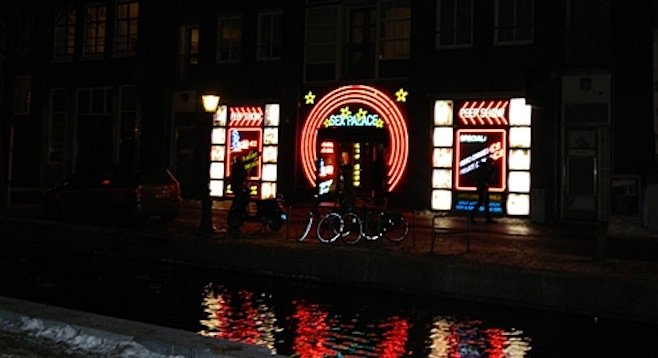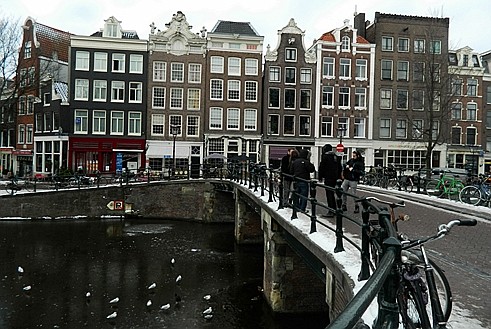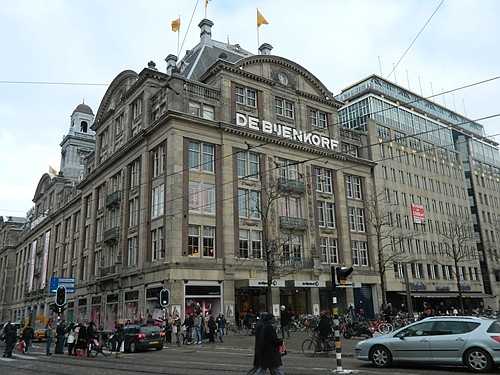 Facebook
Facebook
 X
X
 Instagram
Instagram
 TikTok
TikTok
 Youtube
Youtube

Though it can be fairly said that Amsterdam is always ready for a party, this year the city is really celebrating.

2013 is the 400th anniversary of its famous canal ring, now a UNESCO World Heritage Site. It’s also the 125th anniversary of the Royal Concertgebouw Orchestra. The whole city is celebrating its Golden Age, the era when it was the epicenter for world trade, art, scientific thought and exploration. It’s a good time to visit and see how Amsterdam’s glory days are still ahead.
Where to stay. While the Radisson Blu is in the heart of the Canal District, it’s on a quiet side street – throngs of tourists aren’t dashing back and forth outside.
Radissons are run at a higher level in Europe than in the U.S. The historic building itself is architecturally interesting; it's retained its vintage feel while being repurposed. A grocery was converted into their restaurant, where an elegant complimentary breakfast buffet is served each morning. A rectory was lightly remodeled into a very cozy bar. The rooms themselves are modern and punchy-colorful, with some specially decorated (in gold) for the Golden Age.
The hotel happens to be across the street from the oldest licensed “coffee shop” – where pot is sold legally, for the uninitiated – Rusland Coffee Shop. Customers go up to the “bartender,” who presents a menu of the different varieties of marijuana and hash. You buy what you want by weight and can go downstairs to a tiny rumpus room–type setup to smoke.
There are several other such shops within a block’s walk, as well as several in the Red Light District.
What to do. You can’t really understand the role that canals had in catapulting Amsterdam to world-class status without a canal boat ride. Smidtje offers guided canal tours, and you can arrange for catering and a stocked bar.
The Amsterdam Museum uses everything from Dutch oil painting masterpieces to modern media and even stinky dried hanging codfish to tell the story of “Amsterdam’s DNA” and the Golden Age of Amsterdam. The museum building itself once served as the town orphanage years ago; there's an exhibit on the inner workings of the institution.
The Amsterdam Canal House Museum is really cool, overlooking the Herengracht Canal. They make use of holograms (left), doll houses and sand pits to recreate the 17th-century city planning meetings on how to build the city’s canals. You'll stand gape-mouthed at the almost haunting realism. If you contact them ahead of time, the museum can also work with caterers to recreate a Golden Age dinner from 400 years ago.
One of the saddest, yet most touching museums you’ll ever visit is the Anne Frank House. The cramped attic of a spice factory owned by Anne’s father, Otto Frank, became the hiding place for Anne and her extended family for months on end during the Holocaust. Somebody close to the family – whose identity was never discovered – betrayed them. Anne died at Bergen-Belsen concentration camp. The attic is left unfurnished, as ordered by sole Holocaust survivor Otto, to look just like it did when the Nazis cleared out the place. You’ll want to go early in the morning, as sometimes the wait time to get in can be lengthy.

Appropriately around the corner from the Royal Palace is the ultra-luxe department store, Bijenkorf. Not only do the finest designers have separate boutiques inside, there’s also an oyster-champagne café, a food court, nail salon, eyeglass shop, gourmet store and – just like in the Golden Age of Amsterdam – rare goods from all over the world.
The city of Amsterdam isn't the only one with an anniversary this year. Amsterdam’s symphony and concert hall, the Royal Concertgebouw, is celebrating its 125th anniversary. This world-class orchestra quickly secured its status in its history. The “Dutch sound” it became known for is thanks to its characteristic top-quality woodwind section, nurtured by a local woodwind conservatory.
What to eat. Amsterdam’s Envy has won Michelin’s Bib Gourmand award, but you can dress casually. With their small plates format, it’s easier to keep control of your tab. The restaurant's modeled after Italian meat shops that offer tastes of their wares.
Envy doesn’t have retail, but what they do have is fine Dutch charcuterie, local fish and gourmet treats like fois gras “two ways.” Servers are very knowledgeable about wines. Every tasty detail is thought out, including garnishes of rare microgreens.
Restaurant Anna is in Amsterdam’s oldest and most architecturally interesting section... which just happens to be the Red Light District. The Middle-Aged streets are hyper-narrow there, so your taxi will have to drop you off a couple of blocks away.
When you enter, the brightly lit dining area is divided into two sections. “Everyone” (those in the know) heads to the back. Dare I say it’s kinda preppy? The food is imaginative, well-conceived and delicious: a mini-tomato cupcake with basil frosting was a perfect amuse bouche. You really do forget where you are, until sexy menu items like perfectly poached, runny eggs and exotically spiced figs come out.
Just a few blocks away are the coffeeshops and infamous hookers in the windows (top). Please believe me when I warn you not to try to take their photo. I thought it make a great picture to illustrate this story!
I didn’t know, however, that it's a “thing”: Russian and Bulgarian pimps appeared out of nowhere, trying to corner me into the canal! I blurted out some apology in French, confusing them long enough to make my way past them.


Though it can be fairly said that Amsterdam is always ready for a party, this year the city is really celebrating.

2013 is the 400th anniversary of its famous canal ring, now a UNESCO World Heritage Site. It’s also the 125th anniversary of the Royal Concertgebouw Orchestra. The whole city is celebrating its Golden Age, the era when it was the epicenter for world trade, art, scientific thought and exploration. It’s a good time to visit and see how Amsterdam’s glory days are still ahead.
Where to stay. While the Radisson Blu is in the heart of the Canal District, it’s on a quiet side street – throngs of tourists aren’t dashing back and forth outside.
Radissons are run at a higher level in Europe than in the U.S. The historic building itself is architecturally interesting; it's retained its vintage feel while being repurposed. A grocery was converted into their restaurant, where an elegant complimentary breakfast buffet is served each morning. A rectory was lightly remodeled into a very cozy bar. The rooms themselves are modern and punchy-colorful, with some specially decorated (in gold) for the Golden Age.
The hotel happens to be across the street from the oldest licensed “coffee shop” – where pot is sold legally, for the uninitiated – Rusland Coffee Shop. Customers go up to the “bartender,” who presents a menu of the different varieties of marijuana and hash. You buy what you want by weight and can go downstairs to a tiny rumpus room–type setup to smoke.
There are several other such shops within a block’s walk, as well as several in the Red Light District.
What to do. You can’t really understand the role that canals had in catapulting Amsterdam to world-class status without a canal boat ride. Smidtje offers guided canal tours, and you can arrange for catering and a stocked bar.
The Amsterdam Museum uses everything from Dutch oil painting masterpieces to modern media and even stinky dried hanging codfish to tell the story of “Amsterdam’s DNA” and the Golden Age of Amsterdam. The museum building itself once served as the town orphanage years ago; there's an exhibit on the inner workings of the institution.
The Amsterdam Canal House Museum is really cool, overlooking the Herengracht Canal. They make use of holograms (left), doll houses and sand pits to recreate the 17th-century city planning meetings on how to build the city’s canals. You'll stand gape-mouthed at the almost haunting realism. If you contact them ahead of time, the museum can also work with caterers to recreate a Golden Age dinner from 400 years ago.
One of the saddest, yet most touching museums you’ll ever visit is the Anne Frank House. The cramped attic of a spice factory owned by Anne’s father, Otto Frank, became the hiding place for Anne and her extended family for months on end during the Holocaust. Somebody close to the family – whose identity was never discovered – betrayed them. Anne died at Bergen-Belsen concentration camp. The attic is left unfurnished, as ordered by sole Holocaust survivor Otto, to look just like it did when the Nazis cleared out the place. You’ll want to go early in the morning, as sometimes the wait time to get in can be lengthy.

Appropriately around the corner from the Royal Palace is the ultra-luxe department store, Bijenkorf. Not only do the finest designers have separate boutiques inside, there’s also an oyster-champagne café, a food court, nail salon, eyeglass shop, gourmet store and – just like in the Golden Age of Amsterdam – rare goods from all over the world.
The city of Amsterdam isn't the only one with an anniversary this year. Amsterdam’s symphony and concert hall, the Royal Concertgebouw, is celebrating its 125th anniversary. This world-class orchestra quickly secured its status in its history. The “Dutch sound” it became known for is thanks to its characteristic top-quality woodwind section, nurtured by a local woodwind conservatory.
What to eat. Amsterdam’s Envy has won Michelin’s Bib Gourmand award, but you can dress casually. With their small plates format, it’s easier to keep control of your tab. The restaurant's modeled after Italian meat shops that offer tastes of their wares.
Envy doesn’t have retail, but what they do have is fine Dutch charcuterie, local fish and gourmet treats like fois gras “two ways.” Servers are very knowledgeable about wines. Every tasty detail is thought out, including garnishes of rare microgreens.
Restaurant Anna is in Amsterdam’s oldest and most architecturally interesting section... which just happens to be the Red Light District. The Middle-Aged streets are hyper-narrow there, so your taxi will have to drop you off a couple of blocks away.
When you enter, the brightly lit dining area is divided into two sections. “Everyone” (those in the know) heads to the back. Dare I say it’s kinda preppy? The food is imaginative, well-conceived and delicious: a mini-tomato cupcake with basil frosting was a perfect amuse bouche. You really do forget where you are, until sexy menu items like perfectly poached, runny eggs and exotically spiced figs come out.
Just a few blocks away are the coffeeshops and infamous hookers in the windows (top). Please believe me when I warn you not to try to take their photo. I thought it make a great picture to illustrate this story!
I didn’t know, however, that it's a “thing”: Russian and Bulgarian pimps appeared out of nowhere, trying to corner me into the canal! I blurted out some apology in French, confusing them long enough to make my way past them.
Comments